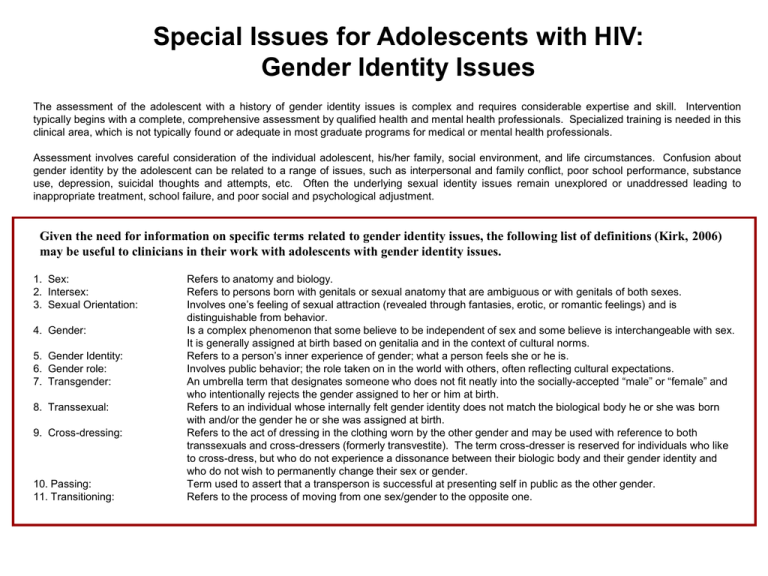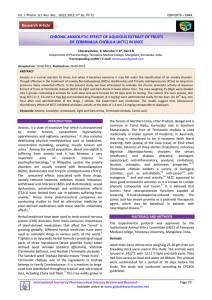
Special Issues for Adolescents with HIV:
Gender Identity Issues
The assessment of the adolescent with a history of gender identity issues is complex and requires considerable expertise and skill. Intervention
typically begins with a complete, comprehensive assessment by qualified health and mental health professionals. Specialized training is needed in this
clinical area, which is not typically found or adequate in most graduate programs for medical or mental health professionals.
Assessment involves careful consideration of the individual adolescent, his/her family, social environment, and life circumstances. Confusion about
gender identity by the adolescent can be related to a range of issues, such as interpersonal and family conflict, poor school performance, substance
use, depression, suicidal thoughts and attempts, etc. Often the underlying sexual identity issues remain unexplored or unaddressed leading to
inappropriate treatment, school failure, and poor social and psychological adjustment.
Given the need for information on specific terms related to gender identity issues, the following list of definitions (Kirk, 2006)
may be useful to clinicians in their work with adolescents with gender identity issues.
1. Sex:
2. Intersex:
3. Sexual Orientation:
4. Gender:
5. Gender Identity:
6. Gender role:
7. Transgender:
8. Transsexual:
9. Cross-dressing:
10. Passing:
11. Transitioning:
Refers to anatomy and biology.
Refers to persons born with genitals or sexual anatomy that are ambiguous or with genitals of both sexes.
Involves one’s feeling of sexual attraction (revealed through fantasies, erotic, or romantic feelings) and is
distinguishable from behavior.
Is a complex phenomenon that some believe to be independent of sex and some believe is interchangeable with sex.
It is generally assigned at birth based on genitalia and in the context of cultural norms.
Refers to a person’s inner experience of gender; what a person feels she or he is.
Involves public behavior; the role taken on in the world with others, often reflecting cultural expectations.
An umbrella term that designates someone who does not fit neatly into the socially-accepted “male” or “female” and
who intentionally rejects the gender assigned to her or him at birth.
Refers to an individual whose internally felt gender identity does not match the biological body he or she was born
with and/or the gender he or she was assigned at birth.
Refers to the act of dressing in the clothing worn by the other gender and may be used with reference to both
transsexuals and cross-dressers (formerly transvestite). The term cross-dresser is reserved for individuals who like
to cross-dress, but who do not experience a dissonance between their biologic body and their gender identity and
who do not wish to permanently change their sex or gender.
Term used to assert that a transperson is successful at presenting self in public as the other gender.
Refers to the process of moving from one sex/gender to the opposite one.
Clinical Resource Guide
Issue
Background
Criteria
Associated Features
Approach
Adolescent
Gender
Identity
Issues
By late adolescence
or adulthood, 3/4 of
males who had a
childhood history of
gender identity
disorder report
homosexual or
bisexual orientation.
The is no data on
females.
• Adolescents
experience similar
gender identity issues
as adults
• Social isolation
which contributes to
low self esteem
• Counseling and individual
psychotherapy to cope with the
psychological, social, and
familial issues
Some adolescents
may develop a
clearer cross-gender
identification and
request sexual
reassignment or may
continue a chronic
course of gender
confusion or
dysphoria.
• Strong or persistent
cross-gender
identification (not
merely a desire for
any perceived cultural
advantages of being
the other sex)
• Persistent discomfort
with his or her own
sex or sense of
inappropriateness in
the gender role of that
sex
• School failure,
aversion, or drop out
due to discomfort or
ostracism
• Preoccupation with
appearance
• Impairment of
relationships with
parents, teachers,
others in authority
• Self treatment with
hormones
• Disturbance is not
concurrent with a
physical intersex
condition
• Engage in sex work
for pay, clothes,
hormones, drugs,
etc.
• Disturbance causes
clinically significant
distress or impairment
in social, occupational,
or other important
areas of functioning
• Anxiety and
depression may be
present
•Suicidality, attempts
• Family counseling
• Educational conferences are
essential to address social
issues in order to avoid
interpersonal issues, school
failure and drop-out
• Psychoeducational approaches
are central to working with all
involved since many teachers,
parents and health
professionals have limited
knowledge of gender identity
issues and related topics
• Effort should be made to
provide the adolescent with
counseling as well as
antidepressants, antianxiety
agents for the treatment of
associated depression and
anxiety if needed
• Referral for substance use
treatment may be indicated if
the adolescent is engaged in
self-medication as a means of
dealing with stress, anxiety,
depression, or peer pressure
References
1.
Adams, Gerald, (2005) Adolescent Development. In T. Gullotta and G. Adams (Eds). Handbook of Adolescent
Behavioral Problems, pp 3-26, New York: Springer Science and Business Media, Inc.
2.
Diagnostic and Statistical Manual of Mental Disorders, 4th Edition, American Psychiatric Association, 2000.
3.
Kazdin, A (2004). Psychotherapy for Children and Adolescents. In M Lambert (Eds), Bergin and Garfield’s
Handbook of Psychotherapy and Behavior Change (5th ed., pp 543-589) New York: John Wiley.
4.
Kirk, S. Frank, L., Clinical Transgender Risk Assessment: A Quick Reference Guide, University of Pittsburgh,
Graduate School of Public Health Pennsylvania/MidAtlantic AETC, 2003
5.
Kirk, S. The Whole Person: A Paradigm for Integrating the Mental and Physical Health of Trans Clients. In
Shankle, M. (Ed). Handbook of Lesbian, Gay, Bisexual and Transgender Public Health: A Practitioner’s Guide to
Service, 2006.
Credits
This tool was developed by the Mental Health subset (Chair: Linda
Frank, PhD, MSN, ACRN, PA/MA AETC) of the AIDS Education and
Training Centers (AETC) National Resource Center, Adolescent
HIV/AIDS Workgroup (Chair: Marion Donohoe, RN, MSN, CPNP, St.
Jude Children’s Research Hospital, ANAC and Ronald Wilcox, MD,
FAAP, Delta Region AETC). Collaborating members include Elizabeth
Cabrera, MEd (TX/OK AETC), Verita Ingram, MBA (TX/OK AETC), Elise
Johnson, MSW (Bickerstaff Pediatric Family Center), Jennifer Scanlon,
FNP (The Children's Hospital, Denver), and Ronald Wilcox. The
workgroup efforts were coordinated by the AETC National Resource
Center (Managing Editor: Megan Vanneman, MPH).









